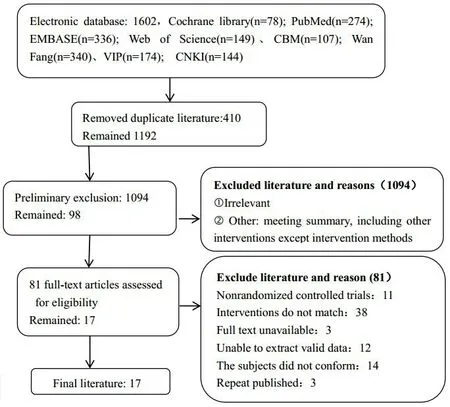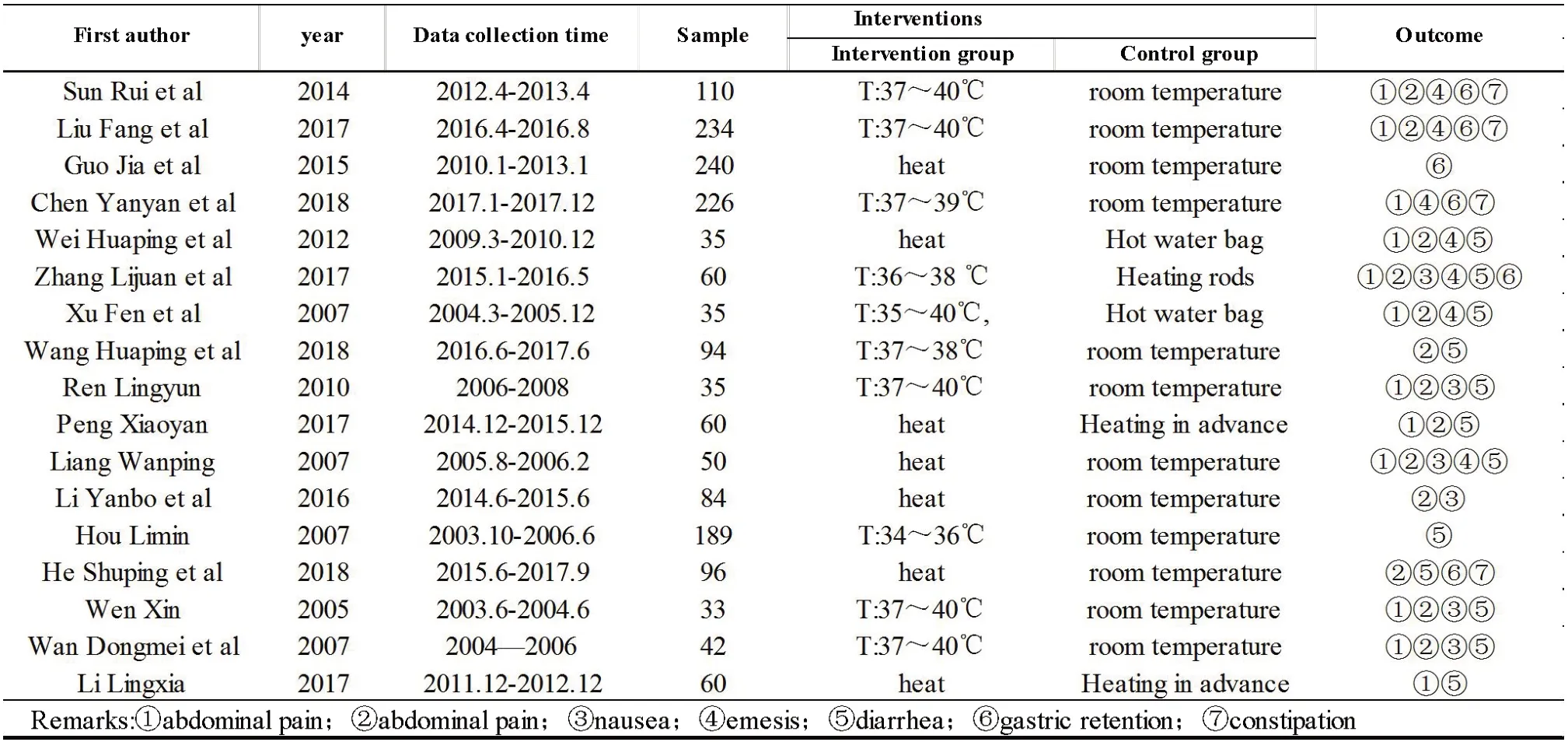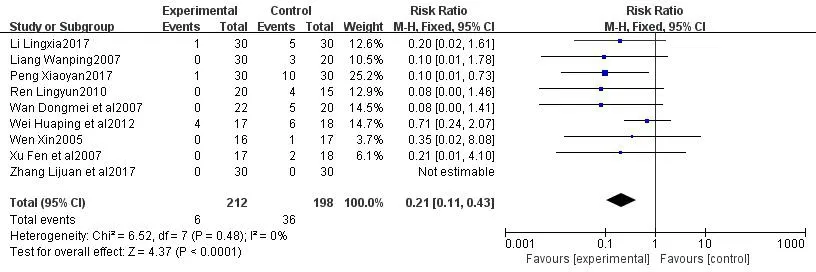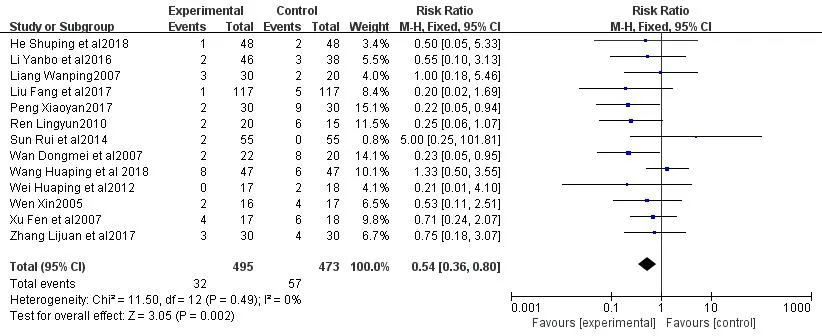Heating infusion for gastrointestinal complications in patients with enteral nutrition: A meta-analysis
Ming Sang, Yan-Qiu Huang, Chang-De Jin
1Department of Graduate, Tianjin University of Traditional Chinese Medicine, Tianjin, 301617, China.
2Department of Nursing, Tianjin University of Traditional Chinese Medicine, Tianjin, 301617, China.
AbstractObjective: To systematically evaluate the effects of heating infusion on gastrointestinal complications of patients with enteral nutrition.Methods: The domestic and foreign databases including Cochrane Library, PubMed, EMBASE, Web of Science, Chinese biomedical literature database (CBM), Wan Fang database (Wan Fang), China National Knowledge Infrastructure (CNKI) and VIP Database for Chinese Technical Periodicals(VIP)were retrieved. The retrieval contents were randomized controlled trials on improving gastrointestinal complications of patients with enteral nutrition by heating infusion of nutrient solution. Data were collected by two reviewers according to the data extraction tables.Results:A total of 17 randomized controlled trials with 1683 subjects were chosen. The results of meta analysis showed that the rate of abdominal pain, abdominal distension and nausea in patients with enteral nutrition could be reduced by warm infusion of nutrient solution, but the effect of the infusion on vomiting, constipation, stomach retention and diarrhea was not superior.Conclusion: Heating infusion of nutrient solution can reduce the incidence of abdominal pain,abdominal distension and nausea in patients with enteral nutrition.
Keywords: Heating infusion; Enteral nutrition; Gastrointestinal complications; Nutrient solution; Meta analysis
1 Introduction
Enteral nutrition (EN) is a method to ensure the patient can get enough protein and calories by inserting a feeding tube into the stomach or intestines through the nasal cavity, oral cavity or gastrostomy fistula on the side, and dripping element diet or liquid food from the tube [1]. The use of enteral nutrition can reduce the risk of complications, the transfer of bacteria from the intestinal tract to the systemic circulation and the level of circulating inflammatory cytokines, and help restore normal intestinal function [2].
Currently, an increasing number of patients are supported by enteral nutrition (EN), which helps to improve the overall nutritional status, increase the body immunity and alleviate the disease development.However, EN support also brings gastrointestinal related complications, such as nausea, vomiting, abdominal distension, diarrhea and stomach retention. Studies have shown that in physiological nutrient solution temperature constant temperature range required (37 °C and 40 °C) nutrition is not affected, and warm nutrition is more advantageous to the intestinal absorption. It can effectively reduce the occurrence of gastrointestinal complications and guarantee the effective implementation of nutrient solution. In clinical practice, nutrient solution is usually heated by a thermostat, but there is a risk of skin burn in the process of using the thermostat. In recent years, clinical trials have been conducted to stop using the thermostat when heating nutrient solution [3].The traditional method includes heating with hot water bottle, hot towel and hand kettle, etc. The disadvantage is that the temperature is high first and then low, which cannot be kept at a constant temperature. It needs to be heated frequently for many times, which not only affects the effect, but also increases the workload of nursing[4]. The international guidelines or consensus nutrient solution need to heating, and the European society of parenteral enteral nutrition guidelines [5] pointed that for patients with serious diseases, early implementation of EN, high temperature can make the gastrointestinal mucosa damage, just rinse with warm water before and after the infusion pipeline, nutrient solution temperature to room temperature, but not specific scopes of nutrient solution temperature. Studies have pointed out that the gastrointestinal tract reaction associated with nutrient solution temperature [6]. When nutrient solution temperature is regulated using heater, keeping the temperature at 38 °C is important to prevent diarrhea nursing [7]. Daly et al. have shown that low-temperature enteral nutrient solution can protect gastric mucosa[8]. There is no unified standard for the current clinical heating methods and the control range of nutrient solution temperature [8]. Some studies have confirmed the occurrence of complications in EN. Besides the characteristics of nutrient solution itself, the temperature of nutrient solution and the speed of nutrient pump are the main causes of complications.
There is still a large number of studies on the effects of nutrient solution temperature and nutrient pump speed on complications. In order to explore the effects of heating infusion of nutrient solution on gastrointestinal complications in EN patients more comprehensively, this study conducted a combined analysis of the results of related randomized controlled trials in order to further explore the clinical effects of heating infusion on enteral nutrition patients.
2 Materials and methods
2.1. Search strategy
Randomized controlled trials on the heating infusion of nutrient solution for gastrointestinal complications in EN patients were searched through the databases including Cochrane Library, PubMed, EMBASE, Web of Science, Chinese biomedical literature database(CBM), Wan Fang database (Wan Fang), China National Knowledge Infrastructure (CNKI) and VIP Database for Chinese Technical Periodicals(VIP) by computer retrieval. English search terms included (“Enteral Nutrition” OR “enteric feeding” OR “feeding tube” OR“feeding bag” OR “nose feeding” OR “gavage tube”OR “nasogastric feeding apparatus” OR “percutaneous endoscopic gastrostomy tube” OR “parenteral nutrition bag” OR “Tube Feeding” OR “Enteral Feeding” OR“Gastric Feeding Tube” OR “Feeding Tubes” OR“Gastric Feeding Tubes” OR “Force Feeding” OR “Force Feedings”) AND (“Temperature”OR “Temperatures”OR “heat*” OR “Warm*” OR “body temperature” OR“core temperature” OR “air temperature” OR “high temperature” OR “transition temperature”). The retrieval strategy was determined after repeated pre-retrieval, and the method of combining subject word and free word was adopted. Meanwhile, the method was supplemented by manual retrieval, and thematic related literatures were traced to avoid missing inspection and ensured the recall rate. The retrieval period was from October 2018.
2.2. Inclusion criteria
Studies selected and analysed in this study should meet the following eligibility criteria: (1) randomised controlled trial (RCT); (2) studies were published in either English or Chinese; (3) the subjects were Indwelled nasogastric tube for gastric feeding; (4) Intervention group: continuous heating infusion of nutrient solution; (5) Control group:normal temperature or preheating nutrient solution; (6)outcome indicators include abdominal pain, bloating,nausea, vomiting, constipation, stomach retention, and diarrhea.
2.3. Exclusion criteria
Studies were excluded if they met any of the following:(1)Fasting, parenteral nutrition, enteral nutrition combined with nutrition; (2) Patients with enteral nutrition in intervention group who underwent other interventions; (3) Case reports, or republished studies with too little information or data to be used.
2.4. Data extraction
First, two researchers independently screened the literature according to inclusion and exclusion criteria, and extracted contents including: authors,years of publication, study design, baseline, sample size, intervention and control measures, and outcome indicators.
Two researchers independently evaluated the methodological quality of the included literature according to the Cochrane manual 5.1.0 version bias risk assessment standard [10]. Evaluation contents included (1) Random sequence generation; (2) Allocation concealment; (3) Blinding of participants and personnel;(4) Blinding of outcome assessment; (5) Incomplete outcome data; (6) Selective reporting; (7) Other bias. If all the included studies fully meet the above standards,the quality grade of the literature is “A”; If part of the literature meets the above quality standards, the quality grade of the literature is “B”; If the above standards are not met completely, the quality grade of the literature is“C”. This study only included references with A quality grade of “A” or “B”. When the evaluation results were inconsistent, the third researcher was consulted.
2.5. Data analysis
In this study, meta-analysis was conducted using the RevMan 5.3 software. Heterogeneity was assessed by I-squared test (I2). Data were described and expressed for dichotomous data with relative risk (RR) and 95%confidence interval (CI). If significant heterogeneity did not exist among studies (I2≤50%, P ≥ 0.1), a fixed effect model was established in the meta-analysis. If significant heterogeneity existed among studies (I2> 50%, P < 0.1),the source of the heterogeneity was analysed. If only statistical heterogeneity was observed among the studies,without clinical heterogeneity, a randomised effect model was constructed. Descriptive analysis was conducted if the heterogeneity was too obvious and the source could be not determined.
3 Results
3.1 Characteristics of the included studies
A total of 1602 literatures, including 837 English literatures, and 765 Chinese literatures were obtained through preliminary database inspection. After screening layer by layer, 17 literatures [11-27] were finally included,and a literature screening flow chart of 1683 patients was shown in figure 1. General information included in the study is shown in table 1.
3.2 Methodological quality of included trials
A total of 17 references were included in this study,all of which were randomized controlled trials.Methodological quality evaluation was performed on 17 studies. Results: the literature quality grade was “B”. The quality evaluation of included research methodology is shown in table 2.
3.3 Incidence of abdominal pain
Nine literatures reported the effect of heated infusion of nutrient solution on abdominal pain of patients with enteral nutrition. The combined results showed no heterogeneity between the studies (P=0.48, I2=0%), so the fixed-effect model was adopted. The results showed that the incidence of abdominal pain in the heating group was lower than that in the control group, and the difference was statistically significant (RR=0.21, 95%CI:0.11~0.43, P<0.001). The results were shown in figure 2.
3.4 Incidence of abdominal distension
Thirteen literatures reported the effect of heated infusion of nutrient solution on abdominal distension of enteral nutrition patients. The combined results showed no heterogeneity between the studies (P=0.49, I2=0%),so the fixed-effect model was adopted. The results showed that the incidence of abdominal distension in the heating group was lower than that in the control group,and the difference was statistically significant (RR=0.54,95%CI: 0.36~0.80, P=0.002). The results were shown in figure 3.
3.5 Incidence of nausea
Five literatures reported the effects of heated infusion of nutrient solution on nausea in patients with enteral nutrition. The combined results showed no heterogeneity between the studies (P=0.34, I2=11%), so the fixedeffect model was adopted. The results showed that the incidence of nausea in the heating group was lower than that in the control group, and the difference was statistically significant (RR=0.28, 95%CI: 013~0.61,P=0.001). The results were shown in figure 4.
3.6 Vomiting incidence
Eight studies reported the effects of heated infusion of nutrient solution on vomiting in patients with enteral nutrition. The combined results showed no heterogeneity between the studies (P=0.26, I2=22%), so the fixed-effect model was adopted. The meta-analysis of the fixed-effect model showed no statistically significant difference in the incidence of vomiting between the heating group and the control group (RR=1.46, 95%CI: 0.75~2.85, P=0.26).The results were shown in figure 5.

Figure 1 Flow chart of the study selection procedure

Table 1 Characteristics of included studies

Table 2 Methodological quality for each included study

Figure 2 comparison of the incidence of abdominal pain between the heating group and the constant temperature group

Figure 3 comparison of the incidence of abdominal distension between the heating group and the constant temperature group

Figure 4 comparison of the incidence of nausea between the heating group and the control group

Figure 4 comparison of vomiting rate between the heating group and the control group
3.7 incidence of constipation
Four literatures reported the effect of heating infusion of nutrient solution on constipation of enteral nutrition patients, and the combined results showed heterogeneity(P=0.03,I2=67%) between the studies, so the random effect model was adopted. The results showed that there was no significant difference in the incidence of constipation between the warming group and the thermostatic group (RR=0.76, 95%CI: 0.42~1.39,P=0.38).
3.8 Incidence of stomach retention
Six literatures reported the effect of heating infusion of nutrient solution on gastric retention in patients with enteral nutrition. The combined results showed that there was heterogeneity between the studies (P=0.007,I2=69%), so the random effect model was adopted. The results showed that there was no significant difference in the incidence of gastric retention between the heating group and the thermostatic group (RR=1.00, 95%CI:0.56~1.78, P=1.00).
3.9 Incidence of diarrhea
Fifteen literatures reported the effect of heated infusion of nutrient solution on diarrhea of enteral nutrition patients, and the combined results showed heterogeneity between the studies (P < 0.0001, I2=71%). Therefore,random effect model was adopted. The results showed that there was no statistically significant difference in the incidence of gastric retention between the two groups(RR=0.66, 95%CI: 0.37~1.17, P=0.15).
4 Discussion
4.1. Methodological quality analysis included in the study
Of the 17 included studies, only 2 have introduced the random grouping method, and no study has clearly introduced the implementation of allocation concealment and measurement blind method, so the possibility of bias is still high, which may affect the reliability of the results.
4.2 Effects of warm infusion of nutrient solution on gastrointestinal complications in patients with enteral nutrition
Enteral nutrition is a way to provide nutrition for patients who are unwilling or unable to ingestion but whose gastrointestinal function exists [28]. The European society of parenteral enteral nutrition (ESPEN) of enteral nutrition in the guide pointed out: the greater the amount of enteral nutrition infusion, the faster the speed,the lower the temperature, complicated with abdominal distention, diarrhea, reflux, aspiration, stomach tube jam, the higher the risk of complications such as gastric retention, the right temperature and speed will be significantly reduced enteral nutrition complications [29].Enteral nutrition can best meet the energy and nutritional needs of patients, correct the negative nitrogen balance in the body, effectively maintain the integrity of gastrointestinal mucosa, protect biological, mechanical and immune functions, and have positive significance for patients' rehabilitation [30]. The results of this meta-analysis showed that the intraperitoneal nutrition patients with abdominal pain, abdominal distension and nausea were significantly improved by warm infusion of nutrient solution. Analysis reason is: the nutrient solution through the mouth eat, habits should be heated to the temperature of the same as the body temperature(37°C and 40°C) after use, enteral nutrient solution temperature is too low, can lead to intestinal mucosal microvascular contraction, lead to intestinal cramps or bowel movements, easy to cause complications such as abdominal pain, abdominal distension, nausea. Low temperature during infusion of nutrient solutions is an important cause of intestinal malnutrition tolerance. On the other hand, due to factors such as infusion speed of nutrient solution, environmental temperature, and indwelling depth of gastric tube, the normal temperature of nutrient solution can not be completely guaranteed to reach human body temperature when it reaches the end of gastric tube. However, the results of this study showed that the warming infusion of nutrient solution had no statistical significance in improving the vomiting,constipation, gastric retention and diarrhea complications in patients with enteral nutrition. The analysis may be related to the subjects included in the study, including elderly patients, patients with severe brain injury, and patients with gastric cancer. Different types of patients with gastrointestinal tolerance can also have a certain gap. In addition, the age and severity of the included subjects were not subdivided, which may result in a certain bias. In clinical use of nutrition pump, should control the appropriate temperature and the appropriate speed. To make EN more in line with the physiological requirements of human body, maintain the function of intestinal mucosa barrier and prevent intestinal infection caused by intestinal bacterial translocation. In order to prevent the occurrence of gastrointestinal reactions,attention should be paid to control "four degrees" when carrying out enteral nutrition, that is, the concentration,speed, temperature and height of bedside elevation of enteral nutrient solution injection. There is no unified standard for the temperature control of nutrient solution,and the results of studies on the effects of temperature on gastrointestinal tract are not uniform.
Limitations of this study:(1)This study only included the Chinese and English literature, which may have the risk of omission and incomplete retrieval;(2) No subgroup analysis was conducted in this study, and future studies can be divided into different subgroups according to the main disease types, duration of warming and infusion methods of patients receiving enteral nutrition, so as to further analyze the effects of warming nutrient solution on gastrointestinal conditions of patients receiving enteral nutrition. To sum up, warm infusion of nutrient solution can reduce partial gastrointestinal complications in patients with enteral nutrition. However, due to the limitations of the quality and quantity of included studies, the above conclusions need to be confirmed by more high-quality studies.
5 Conclusions
In this study, it was shown that the heating infusion of nutrient solution could improve the abdominal pain,abdominal distension and nausea of the patients, which proved that the heating infusion of nutrient solution had a certain effect on the enteral nutrition patients. However,it is still to be verified by large sample and high-quality RCT that whether warm infusion of nutrient solution can improve the condition of constipation, stomach retention and diarrhea. At the same time, it is suggested that RCT for enteral nutrition patients to warm up the infusion of nutrient solution can be subdivided into the age, gender,major disease types, severity, duration of intervention and other aspects of the subjects, so as to determine the optimal suitable temperature of the infusion, and there by improve the prognosis of patients.
- Medical Data Mining的其它文章
- Reanalysis of Lymph node metastasis as predictor of the survival of patients with follicular variant papillary thyroid carcinoma: From SEER database 2004-2014
- Efficacy and safety of atomized inhalation for Shuanghuanglian on chronic pharyngitis:a Meta-analysis of the randomized controlled trials
- Literature Research on Drug Use Regulation of Miao Medicine in Suppression of Gastric Cancer
- Clinical Medicine Characteristics Study of Traditional Chinese Medicine in the treatment of cancer pain based on Data Mining

